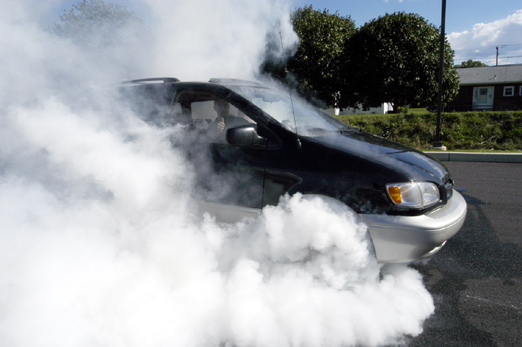|
|
|
|
|
|
 |
|
|
|
|
|
|||||
|
|
||||
|
|
|||||
Publications: Reading Eagle DriveTime: Articles
|
Tweaking horsepower: Making slow cars faster By
Jeffrey Fazio Sports cars and muscle cars are not for everyone. Chances are that if you are a true horsepower junkie, you own a little hot rod and probably already know a thing or two about getting more horsepower (hp) from it. But
what about the rest? The
good news for them is that the tricks for making fast cars faster also
works for their cars. Jeff Hart, assistant manager in training at Advance Auto Sales, Muhlenberg Township, expressed a similar plan of attack for the domestic cars, but added spark plug wires and throttle bodies to the list of upgrades. The first step, Rado explained, is getting more air into the engine. The simplest and cheapest way to do this is by swapping out a factory air filter for a freer-flowing element like a K&N air filter. Just by dropping in a different filter you may gain two to three horsepower. If there is a desire for even more gusto, a full intake system can be purchased. Rado explained that a full intake will replace the original manufacturer's equipment (OEM) filter, piping and air box, offering as much as eight additional horsepower. Once the amount of air going into the motor is increased, the next step is getting that air out faster. Rado pointed out the need for upgrading exhaust systems during the quest for more power. "A small increase in exhaust pipe diameter will benefit any import. Adding just an exhaust tip offers no performance advantage whatsoever and could possible hurt you (your performance). It also makes your car sound like a dying lawnmower, which no one likes," Rado said. "A
full exhaust is key to gaining horsepower," said Hart. Hart went on to explain that a full exhaust includes headers (or manifold), pipes, catalytic converters and mufflers all the way back to the tips. A "cat back" exhaust usually includes only the pipes and muffler after the catalytic converter. Spark
plugs are another place the average Joe can get some extra muscle from
their cars. Hart
explained that each domestic car responds differently to a variety of
spark plugs, so he recommends experimenting. He said a lot of
American-made cars perform well with the Delco or Autolite plugs. Hart explained, "The addition of an ignition box, like the MSD 6AL, gives more voltage to the ignition (bigger spark) which results in the fuel burning faster giving more horsepower." When adding an ignition box and performance spark plugs, Hart also recommended upgrading the ignition wires on a domestic car. He expressed that a thicker spark plug wire will provide more spark and better power. In
contrast, Rado, warned against the use of aftermarket spark plug wires
on imported cars. Hart added throttle bodies as one last place to look for a bit more performance. He explained that some cars can benefit from a larger throttle body. Installing a larger throttle body allows more air to enter the engine and complements intake system upgrades. One last warning Rado offered was in reference to aftermarket pulleys. Some companies offer lightweight pulleys for quick and easy horsepower. The idea behind a lightweight pulley is that they reduce the rotational weight in an engine which allows the engine to spin faster and easier. The
problem, Rado elaborated, is that these pulleys replace the harmonic
balancer that is part of the OEM pulley. The harmonic balancer plays a
significant role in balancing the engine. In
looking for aftermarket parts for a car, Hart advised, "Look at a
bunch of companies. The most expensive is not necessarily better. A
lot of pricing is off of name brand." |

